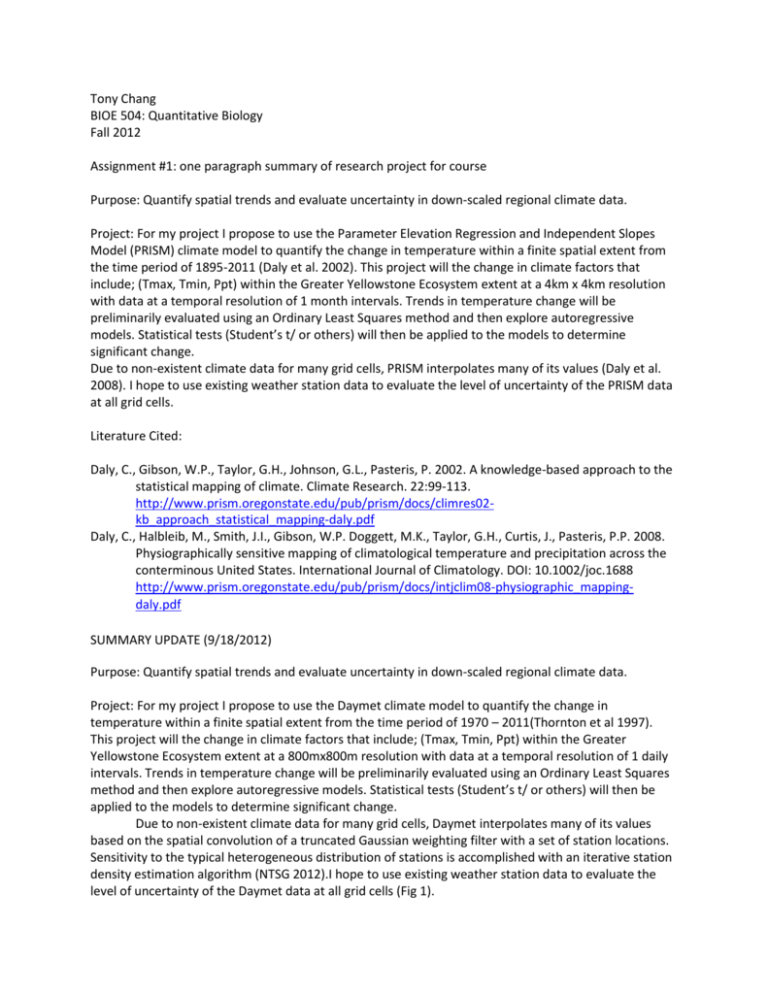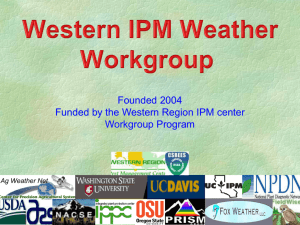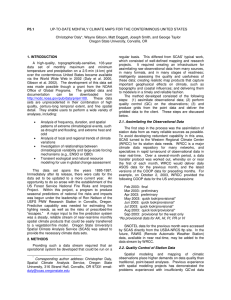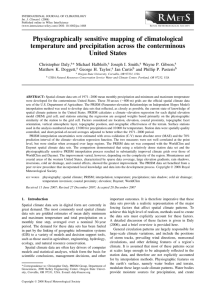Tony - Environmental Statistics Group
advertisement

Tony Chang BIOE 504: Quantitative Biology Fall 2012 Assignment #1: one paragraph summary of research project for course Purpose: Quantify spatial trends and evaluate uncertainty in down-scaled regional climate data. Project: For my project I propose to use the Parameter Elevation Regression and Independent Slopes Model (PRISM) climate model to quantify the change in temperature within a finite spatial extent from the time period of 1895-2011 (Daly et al. 2002). This project will the change in climate factors that include; (Tmax, Tmin, Ppt) within the Greater Yellowstone Ecosystem extent at a 4km x 4km resolution with data at a temporal resolution of 1 month intervals. Trends in temperature change will be preliminarily evaluated using an Ordinary Least Squares method and then explore autoregressive models. Statistical tests (Student’s t/ or others) will then be applied to the models to determine significant change. Due to non-existent climate data for many grid cells, PRISM interpolates many of its values (Daly et al. 2008). I hope to use existing weather station data to evaluate the level of uncertainty of the PRISM data at all grid cells. Literature Cited: Daly, C., Gibson, W.P., Taylor, G.H., Johnson, G.L., Pasteris, P. 2002. A knowledge-based approach to the statistical mapping of climate. Climate Research. 22:99-113. http://www.prism.oregonstate.edu/pub/prism/docs/climres02kb_approach_statistical_mapping-daly.pdf Daly, C., Halbleib, M., Smith, J.I., Gibson, W.P. Doggett, M.K., Taylor, G.H., Curtis, J., Pasteris, P.P. 2008. Physiographically sensitive mapping of climatological temperature and precipitation across the conterminous United States. International Journal of Climatology. DOI: 10.1002/joc.1688 http://www.prism.oregonstate.edu/pub/prism/docs/intjclim08-physiographic_mappingdaly.pdf SUMMARY UPDATE (9/18/2012) Purpose: Quantify spatial trends and evaluate uncertainty in down-scaled regional climate data. Project: For my project I propose to use the Daymet climate model to quantify the change in temperature within a finite spatial extent from the time period of 1970 – 2011(Thornton et al 1997). This project will the change in climate factors that include; (Tmax, Tmin, Ppt) within the Greater Yellowstone Ecosystem extent at a 800mx800m resolution with data at a temporal resolution of 1 daily intervals. Trends in temperature change will be preliminarily evaluated using an Ordinary Least Squares method and then explore autoregressive models. Statistical tests (Student’s t/ or others) will then be applied to the models to determine significant change. Due to non-existent climate data for many grid cells, Daymet interpolates many of its values based on the spatial convolution of a truncated Gaussian weighting filter with a set of station locations. Sensitivity to the typical heterogeneous distribution of stations is accomplished with an iterative station density estimation algorithm (NTSG 2012).I hope to use existing weather station data to evaluate the level of uncertainty of the Daymet data at all grid cells (Fig 1). Fig 1. Climate trend grid generated using simple linear regression model at the cell level to determine spatial relationships to climate change. Project is directed at assigning cell level uncertainty for future application of drawing climate trend relationships with ecological datasets. First steps in uncertainty grid construction will be the application of a jack knife cross validation method to determine the Mean Absolute Error (MAE) and bias at known stations used in model interpolation (Fig 2). Following this, a validation analysis will be performed on unused stations to determine additional MAE and bias on the interpolation. Fig 2: Example of a predicted vs. observed daily climate factor plot. Points closer to slope line represent correctly predicted values. Numerical Terradynamic Simulation Group (NTSG). 2012. Spatial Bioclimatology. <http://www.ntsg.umt.edu/project/daymet>. Accessed Sep. 18, 2012. Thornton, P.E., Running, S.W., and White, M.A. 1997. Generating surfaces of daily meteorological variables over large regions of complex terrain. Journal of Hydrology 190:214-251










